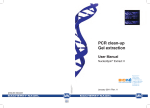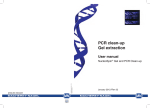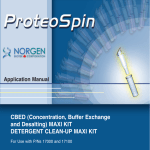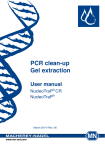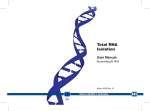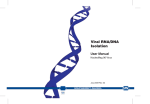Download PCR clean-up Gel extraction
Transcript
PCR clean-up Gel extraction User manual NucleoSpin® Extract II September 2005/Rev. 02 www.mn-net.com MACHEREY-NAGEL MN MACHEREY-NAGEL DIN EN ISO 9001: 2000 CERTIFIED MACHEREY-NAGEL MN Protocol at a glance (Rev. 02) NucleoSpin® Extract II Gel extraction PCR clean-up 1 Excise DNA fragment 2 Gel lysis / Adjust binding conditions 200 µl NT / 100 mg 200 µl NT / 100 µl 50°C 5-10 min 3 Bind DNA 1 min 11,000 x g 4 Wash silica membrane 600 µl NT3 1 min 11,000 x g 5 Dry silica membrane 2 min 11,000 x g 6 Elute DNA 15-50 µl NE 1 min RT 1 min 11,000 x g PCR clean-up, Gel extraction Table of contents 1 Kit contents 4 2 Product description 5 2.1 The basic principle 5 2.2 About this user manual 5 2.3 Kit specifications 5 2.4 Removal of small DNA fragments and primer-dimers 6 2.5 Elution procedures 8 3 Storage conditions and preparation of working solutions 10 4 Safety instructions – risk and safety phrases 11 5 Protocol for DNA extraction from agarose gels 12 6 Protocol for direct purification of PCR products 14 7 Support protocols 16 7.1 Concentration and removal of salts, enzymes, etc. Purification of samples without SDS (buffer NT) 16 7.2 Concentration and removal of salts, enzymes, etc. Purification of samples containing SDS (buffer NTB) 16 7.3 Purification of single stranded DNA (buffer NTC) 17 8 Appendix 18 8.1 Troubleshooting 18 8.2 Ordering information 19 8.3 References 20 8.4 Product use restriction / warranty 20 MACHEREY-NAGEL – 09/2005/Rev 02 3 PCR clean-up, Gel extraction 1 Kit contents NucleoSpin® Extract II 10 preps 50 preps 250 preps Cat. No. 740609.10 740609.50 740609.250 Buffer NT 6 ml 30 ml 2 x 75 ml Buffer NT3 (concentrate) 7 ml 2 x 7 ml 40 ml Buffer NE 5 ml 15 ml 50 ml NucleoSpin® Extract II columns (yellow) 10 50 250 NucleoSpin® collecting tubes (2 ml) 10 50 250 Protocol 1 1 1 4 MACHEREY-NAGEL – 09/2005/Rev 02 PCR clean-up, Gel extraction 2 Product description 2.1 The basic principle With the NucleoSpin® Extract II method, DNA binds to a silica membrane in the presence of chaotropic salt added by binding buffer NT. The binding mixture is loaded directly onto NucleoSpin® Extract II columns. Contaminations like salts and soluble macromolecular components are removed by a simple washing step with ethanolic buffer NT3. Pure DNA is finally eluted under low ionic strength conditions with slightly alkaline buffer NE (5 mM Tris/HCl, pH 8.5). 2.2 About this user manual Experienced users who are performing the purification of PCR* products or DNA fragments from agarose gels using a NucleoSpin® Extract II isolation kit may refer to the Protocol-at-a-glance instead of this user manual. The Protocol-at-a-glance is designed to be used only as a supplemental tool for quick referencing while performing the purification procedure. First-time users are strongly advised to read the entire user manual. 2.3 Kit specifications * • The NucleoSpin® Extract II kit is designed for the purification of DNA from TAE/TBE agarose gels and for direct purification of PCR* products (two applications in one kit). • The NucleoSpin® Extract II buffer formulation ensures complete removal of primers from PCR* reactions while small DNA fragments are still bound and purified with high recovery. • With NucleoSpin® Extract II even DNA fragments from PCR* reaction buffers rich in various detergents can be purified with high recovery. • The adsorption of DNA to the NucleoSpin® Extract II membrane is pHdependent. Optimal recovery is achieved by using TAE standard gels or reaction mixtures with pH 6-8. • Standard as well as low melting agarose gels can be used. • The prepared DNA fragments can be used directly in applications like automated fluorescent DNA sequencing, PCR*, or any kind of enzymatic manipulation. PCR is patented by Roche Diagnostics MACHEREY-NAGEL – 09/2005/Rev 02 5 PCR clean-up, Gel extraction Kit specification at a glance NucleoSpin® Extract II Parameters DNA fragments from agarose gels Concentration, removal of salts, enzymes, nucleotides a/o labeling reagents like biotin or radioactive ATP etc. Direct purification of amplified DNA Elution volume Binding capacity 15-50 µl 15 µg 10 min for 6 preps Time/prep Purification of reaction mixtures without SDS see section 7.1 Purification of reaction mixtures containing SD see section 7.2 Purification of single stranded DNA see section 7.3 Removal of small DNA fragments and primer-dimers see section 2.4 2.4 Removal of small DNA fragments and primer-dimers NucleoSpin® Extract II is designed to remove even traces of unused primers and at the same time to purify PCR products down to 65 bp. However, in some cases it is necessary to exclude these small fragments, e.g. primer-dimers or side products resulting from unspecific annealing, since they might interfere with your downstream sequencing or cloning applications. Removal of double stranded DNA <65 bp can be achieved by diluting an aliquot of buffer NT with sterile water in an appropriate ratio and then proceed with the standard protocol (see section 6). Diluting buffer NT in a certain range lowers the binding efficiency for small fragments without compromising the recovery of larger PCR products. Which dilution ratio to choose depends on the fragment size that is to be purified as well as on the PCR buffer system that is used. Influence of fragment size: The smaller the fragment in question is, the less you have to dilute buffer NT. 6 MACHEREY-NAGEL – 09/2005/Rev 02 PCR clean-up, Gel extraction Influence of PCR buffer system: The influence of the PCR buffer system on the removal of small fragments is more complex. Some reaction buffers contain detergents like Tween or high concentrations of additives like betaine to lower the melting temperature of the DNA template. These substances can usually be found in PCR buffers for high fidelity or long range PCR. They tend to lower the binding efficiency of DNA to the silica membrane and therefore have to be considered when choosing a dilution ratio of buffer NT. As a rule of thumb if a PCR buffer system without special additives is used, adding 3 to 5 volumes of water to 1 volume of buffer NT will lead to removal of small fragments up to 100 bp. Otherwise adding 1 to 3 volumes of water to 1 volume of buffer NT will be sufficient. So for each size of small fragments <65 bp that has to be removed and for each PCR system there may be checked the appropriate ratio of buffer NT dilution in advance. Figure 1 shows a purification result with an NT dilution series. Pure NT (lane 3) as well as NT plus one volume of water (lane 4) lead to 100% recovery of a PCR fragment ladder (lane 2). Use of more diluted buffer NT cuts off more and more of the low molecular mass bands. Usually a dilution with 5 volumes of water should be sufficient to eliminate even larger unwanted primer-dimer fragments while purifying the 164 bp fragment with >90%. 1 2 3 4 5 6 7 8 9 10 11 12 [bp] 982 645 359 164 100 79 65 50 dilution factor 1/1 1/2 1/3 1/4 1/5 1/6 1/7 1/8 1/9 21 Figure 1 Purification of PCR reactions using buffer NT dilutions Lane 1: Lane 2: GeneRuler 100 bp DNA Ladder (MBI Fermentas) DNA ladder input (21 b primer, 50, 65, 79, 100, 164, 359, 645 and 982 bp fragment) amplified using Biotaq DNA Polymerase (Bioline) Lane 3: Purification with 100% NT Lane 4-12: Purification with NT diluted with 1-9 volumes of water MACHEREY-NAGEL – 09/2005/Rev 02 7 PCR clean-up, Gel extraction 2.5 Elution procedures • For elution of DNA one of the following solutions can be used: Buffer NE (supplied, 5 mM Tris/HCl, pH 8.5) / TE buffer, pH 8.5 / distilled water, pH 8.5. • Note: EDTA in TE buffer may cause problems in subsequent reactions, and the pH of distilled water should be checked before use to avoid lower recovery yields. See Table 1 for the correlation between dispensed elution buffer volumes and typical recoveries for purification of 1-5 µg of PCR* fragments (for gel extraction, recovery is approx. 10 % lower). • With an elution volume of 15 µl of buffer NE a typical recovery of 70-95 % is usually obtained for DNA fragments between 50-10,000 bp resulting in highly concentrated eluates (see Table 1, Figure 2). If larger amounts (5-15 µg) of DNA have to be purified (e.g. from PCR* reactions > 100 µl or gel slices > 200 mg) elution with at least 50 µl of buffer NE is recommended. Primers are not bound. • Yields of larger fragments (> 5-10 kb) can be increased by using prewarmed elution buffer (70°C): For elution, add prewarmed elution buffer NE and incubate for 1-2 min before collecting eluate by centrifugation. For fragments >10 kb the use of our NucleoTraP® CR kit is recommended. Table 1: DNA Recovery with NucleoSpin® Extract II Fragment length * Elution volume Recovery 65 bp 15 µl 25 µl 50 µl 100 µl 85 % 90 % 95 % 95 % 400 bp 15 µl 25 µl 50 µl 100 µl 85 % 95 % 100 % 100 % 700 bp 15 µl 25 µl 50 µl 100 µl 85 % 90 % 95 % 95 % 1500 bp 15 µl 25 µl 50 µl 100 µl 85 % 85 % 90 % 95 % PCR is patented by Roche Diagnostics 8 MACHEREY-NAGEL – 09/2005/Rev 02 PCR clean-up, Gel extraction Reference ladder (%) Elution volume (µl) 100 75 50 25 15 15 15 15 20 20 20 20 25 25 25 25 Recovery (%) 75 100 Figure 2 DNA recovery with different elution volumes A PCR sample with a fragment size of 782 bp was purified from a 1 % agarose gel according to the standard protocol of NucleoSpin® Extract II using different elution volumes as shown. All elution volumes were adjusted to 25 µl plus 4.5 µl loading dye. For analysis the mixture was loaded on a 1 % TAE gel. The recovery was estimated by comparison with a fragment ladder. MACHEREY-NAGEL – 09/2005/Rev 02 9 PCR clean-up, Gel extraction 3 Storage conditions and preparation of working solutions Attention: Buffer NT contains chaotropic salt. Wear gloves and goggles! • The NucleoSpin® Extract II kit should be stored at room temperature and is stable for up to one year. Before starting any NucleoSpin® Extract II protocol prepare the following: • Add the indicated volume of 96-100% ethanol to buffer NT3 concentrate. NucleoSpin® Extract II Cat. No. Buffer NT3 10 10 preps 50 preps 250 preps 740609.10 740609.50 740609.250 7 ml add 28 ml ethanol 2 x 7 ml add 28 ml ethanol 40 ml add 160 ml ethanol MACHEREY-NAGEL – 09/2005/Rev 02 PCR clean-up, Gel extraction 4 Safety instructions – risk and safety phrases The following components of the NucleoSpin® Extract II kits contain hazardous contents. Wear gloves and goggles and follow the safety instructions given in this section Buffer Hazard Contents NT guanidine thiocyanate Hazard Symbol Risk Safety Phrases Phrases Xn Harmful by inhalation, in contact R 20/21/22 S 13 with skin and if swallowed Risk Phrases R 20/21/22 Harmful by inhalation, in contact with the skin and if swallowed Safety Phrases S 13 Keep away from food, drink and animal feedstuffs Label not necessary, if quantity below 125 g or ml (concerning 67/548/EEC Art. 25, 1999/45/EC Art. 12 and German GefStoffV § 42 and TRGS 200 7.1) MACHEREY-NAGEL – 09/2005/Rev 02 11 NucleoSpin® Extract II 5 1 Protocol for DNA extraction from agarose gels Excise DNA fragment Take a clean scalpel to excise the DNA fragment from an agarose gel. Excise gel slice containing the fragment carefully to minimize the gel volume. Determine the weight of the gel slice and transfer it to a clean tube. 2 Gel lysis For each 100 mg of agarose gel add 200 µl buffer NT. For gels containing > 2 % agarose, double the volume of buffer NT. The maximum amount of gel slice per NucleoSpin® Extract II column is 400 mg or 200 mg of a high percentage gel > 2 %. In this case 2 loading steps are required (step 3). Incubate sample at 50°C until the gel slices are dissolved (5-10 min). Vortex the sample briefly every 2-3 min until the gel slices are dissolved completely! 3 50°C, 5-10 min Bind DNA Place a NucleoSpin® Extract II column into a 2 ml collecting tube and load the sample. Centrifuge for 1 min at 11,000 x g. Discard flow-through and place the NucleoSpin® Extract II column back into the collecting tube. 4 + 200 µl NT per 100 mg gel load sample 1 min, 11,000 x g Wash silica membrane + 600 µl NT3 A d d 600 µl buffer N T 3 . Centrifuge for 1 min at 11,000 x g. Discard flow-through and place the NucleoSpin® Extract II column back into the collecting tube. 12 MACHEREY-NAGEL – 09/2005/Rev 02 1 min, 11,000 x g NucleoSpin® Extract II 5 Dry silica membrane Centrifuge for 2 min at 11,000 x g to remove buffer NT3 quantitatively. Make sure the spin column doesn’t come in contact with the flow-through while removing it from the centrifuge and the collecting tube. 2 min, 11,000 x g Residual ethanol from buffer NT3 might inhibit subsequent reactions and has to be removed in this step. In addition to centrifugation, total removal can be achieved by incubation of NucleoSpin® Extract II columns for 2-5 min at 70°C prior to elution. 6 Elute DNA Place the NucleoSpin® Extract II column into a clean 1.5 ml microcentrifuge tube. Add 15-50 µl elution buffer NE and incubate at room temperature for 1 min to increase the yield of eluted DNA. Centrifuge for 1 min at 11,000 x g. Yield of larger fragments (> 5-10 kb) can be increased by using prewarmed elution buffer (70°C): For elution, add prewarmed elution buffer and incubate at room temperature for 1 min before collecting eluate by centrifugation. MACHEREY-NAGEL – 09/2005/Rev 02 + 15-50 µl NE 1 min, 11,000 x g 13 NucleoSpin® Extract II 6 1 Protocol for direct purification of PCR products Adjust DNA binding conditions Mix 1 volume of sample with 2 volumes of buffer NT (e.g. mix 100 µl PCR reaction and 200 µl NT). + 2 vol NT per For sample volumes < 50 µl adjust the volume of the reaction mix to 50 µl using TE buffer (pH 7.5). 1 vol sample For removal of DNA fragments < 65 bp, dilutions of buffer NT can be used instead of 100 % NT. Please refer to section 2.4. 2 Bind DNA Place a NucleoSpin® Extract II column into a 2 ml collecting tube and load the sample. Centrifuge for 1 min at 11,000 x g. Discard flow-through and place the NucleoSpin® Extract II column back into the collecting tube. 3 load sample 1 min, 11,000 x g Wash silica membrane + 600 µl NT3 A d d 600 µl buffer N T 3 . Centrifuge for 1 min at 11,000 x g. Discard flow-through and place the NucleoSpin® Extract II column back into the collecting tube. 4 Dry silica membrane Centrifuge for 2 min at 11,000 x g to remove buffer NT3 quantitatively. Make sure the spin column doesn’t come in contact with the flow-through while removing it from the centrifuge and the collecting tube. Residual ethanol from buffer NT3 might inhibit subsequent reactions and has to be removed in this step. In addition to centrifugation, total removal can be achieved by incubation of NucleoSpin® Extract II columns for 2-5 min at 70°C prior to elution. 14 1 min, 11,000 x g MACHEREY-NAGEL – 09/2005/Rev 02 2 min, 11,000 x g NucleoSpin® Extract II 5 Elute DNA Place the NucleoSpin® Extract II column into a clean 1.5 ml microcentrifuge tube. Add 15-50 µl elution buffer NE and incubate at room temperature for 1 min to increase the yield of eluted DNA. Centrifuge for 1 min at 11,000 x g. Yield of larger fragments (> 5-10 kb) can be increased by using prewarmed elution buffer (70°C): For elution, add prewarmed elution buffer and incubate at room temperature for 1 min before collecting eluate by centrifugation. MACHEREY-NAGEL – 09/2005/Rev 02 + 15-50 µl NE 1 min, 11,000 x g 15 NucleoSpin® Extract II 7 Support protocols 7.1 Concentration and removal of salts, enzymes, etc. Purification of samples without SDS (buffer NT) Note: Buffer NT is provided with the NucleoSpin® Extract II kits. 1 Adjust DNA binding conditions Mix 1 volume of sample with 2 volumes of buffer NT (e.g. 200 µl NT and 100 µl reaction mixture). + 2 vol NT per 1 vol sample If your sample contains large amounts of detergents or other critical substances, double the volume of NT. 2 Bind DNA Continue with step 2 of the protocol for direct purification of PCR products (section 6). 7.2 Concentration and removal of salts, enzymes, etc. Purification of samples containing SDS (buffer NTB) The NucleoSpin® Extract II buffer NT is compatible with most commonly used detergents except sodium dodecyl sulfate (SDS). For purification of DNA from SDS containing buffers, e.g. in applications like “Chromatin Immunoprecipitation” (CHiP), the SDS compatible binding buffer NTB can be used. Note: Buffer NTB has to be ordered separately (150 ml NTB, Ref. 740595.150, see Ordering information). 1 Adjust DNA binding conditions Mix 1 volume of sample with 5 volumes of buffer NTB (e.g. 100 µl reaction with 500 µl NTB). 2 Bind DNA Continue with step 2 of the protocol for direct purification of PCR products (section 6). 16 MACHEREY-NAGEL – 09/2005/Rev 02 + 5 vol NTB per 1 vol sample NucleoSpin® Extract II 7.3 Purification of single stranded DNA (buffer NTC) The NucleoSpin® Extract II buffer NT is able to bind single stranded DNA (ssDNA) > 150 bases. Shorter oligonucleotides, especially primers, are completely removed. If you need to purify short ssDNA, the additional binding buffer NTC can be used (see Figure 3). Note: Buffer NTC has to be ordered separately (100 ml NTC, Ref. 740654.100, see Ordering information). 1 Adjust DNA binding conditions Mix 1 volume of sample with 2 volumes of buffer NTC (e.g. 100 µl PCR reaction mix and 200 µl NTC). + 2 vol NTC per 1 vol sample If your sample contains large amounts of detergents or other critical substances, double the volume of NTC. 2 Bind DNA Continue with step 2 of the protocol for direct purification of PCR products (section 6). 1 2 3 - 490 bp - 490 bases - 164 bp - 164 bases - 100 bases - 64 bases - 18 bases u NT NTC Figure 3 Purification of dsDNA and ssDNA using buffers NT and NTC PCR fragments, amplified using one phosphorylated and one dephosphorylated primer, were partially digested with l-Exonuclease. Samples were purified using binding buffers NT and NTC and run on a 1 % TAE agarose gel. Remaining double stranded DNA can be seen as faint bands. The corresponding single stranded DNA is running slightly faster due to secondary structure formation. Compared to the input DNA (u, lane 1), NT removes ssDNA < 150 bases (NT, lane 2), whereas NTC leads to full recovery of even primer oligonucleotides (NTC, lane 3). MACHEREY-NAGEL – 09/2005/Rev 02 17 PCR clean-up, Gel extraction 8 Appendix 8.1 Troubleshooting Problem Possible cause and suggestions High amount of agarose • Incomplete lysis of agarose slices Use doubled volumes of buffer NT for highly concentrated a/o LMP (low melting point) agarose gels. Time and temperature • Check incubation temperature. Depending on the weight of the gel slice, incubation (section 5, step 2) can be prolonged up to 20 min. Vortex every 2 min and check integrity of the gel slice. Very large gel slices can be quenched or crushed before addition of buffer NT. Reagents not applied properly • Add indicated volume of 96-100% ethanol to buffer NT3 concentrate and mix well before use. Incompletely dissolved gel slice • Increase time or add another two volumes of NT and vortex the tube every 2 minutes during incubation at 50°C. Small pieces of gel are hardly visible and contain DNA that will be lost for purification. Insufficient drying of the NucleoSpin® Extract II silica membrane Low DNA yield • Centrifuge 5 min at 11,000 x g or incubate column for 2-5 min at 70°C before elution to remove ethanolic buffer NT3 completely. Ethanolic contaminations are also indicated by gel-loading problems (samples float out of gel slots). Remove the spin cup carefully from centrifuge and collecting tube and avoid contact of spin cup with flow-through. Not enough elution buffer • Especially when larger amounts of DNA (> 5 µg) are bound, increase elution buffer volume up to 100 µl. Isolation of large DNA fragments • 18 Preheat elution buffer NE to 70°C, and incubate on the silica membrane at room temperature for 2 min before centrifugation. MACHEREY-NAGEL – 09/2005/Rev 02 PCR clean-up, Gel extraction Problem Possible cause and suggestions Carry-over of ethanol/ethanolic buffer NT3 • Suboptimal performance of DNA in sequencing reactions Centrifuge 5 min at 11,000 x g or incubate column for 2-5 min at 70°C before elution to remove ethanolic buffer NT3 completely. Ethanolic contaminations are also indicated by gel-loading problems (samples float out of gel slots). Remove the spin cup carefully from centrifuge and collecting tube and avoid contact of spin cup with flow-through. Elution of DNA with buffers other than buffer NE e.g. TE buffer (Tris/EDTA) • EDTA might inhibit sequencing reactions. In this case it is recommended to re-purify DNA and elute in buffer NE or water. Not enough DNA used for sequencing reaction • Quantify DNA by agarose gel electrophoresis before setting up sequencing reactions. 8.2 Ordering information Product Cat. No. Pack of NucleoSpin® Extract II 740609.10 10 preps NucleoSpin® Extract II 740609.50 50 preps NucleoSpin® Extract II 740609.250 250 preps Buffer NT 740614.100 100 ml Buffer NTB 740595.150 150 ml Buffer NTC 740654.100 100 ml Buffer NT3 concentrate (for 100 ml buffer) 740598 20 ml NucleoSpin® collecting tubes (2 ml) 740600 1000 MACHEREY-NAGEL – 09/2005/Rev 02 19 PCR clean-up, Gel extraction 8.3 References Vogelstein B., and D. Gillespie. 1979. Preparative and analytical purification of DNA from agarose. Proc. Natl. Acad. Sci. USA 76: 615-619. 8.4 Product use restriction / warranty NucleoSpin® Extract II kit components were developed, designed and sold for research purposes only. They are suitable for in vitro uses only. No claim or representation is intended for its use to identify any specific organism or for clinical use (diagnostic, prognostic, therapeutic, or blood banking). It is rather the responsibility of the user to verify the use of the NucleoSpin® Extract II kit for a specific application range as the performance characteristic of this kit has not been verified to a specific organism. This MACHEREY-NAGEL product is shipped with documentation stating specifications and other technical information. MACHEREY-NAGEL warrants to meet the stated specifications. MACHEREY-NAGEL´s sole obligation and the customer´s sole remedy is limited to replacement of products free of charge in the event products fail to perform as warranted. Supplementary reference is made to the general business terms and conditions of MACHEREY-NAGEL, which are printed on the price list. Please contact us if you wish an extra copy. MACHEREY-NAGEL does not warrant against damages or defects arising in shipping and handling (transport insurance for customers excluded), or out of accident or improper or abnormal use of this product; against defects in products or components not manufactured by MACHEREY-NAGEL, or against damages resulting from such non-MACHEREY-NAGEL components or products. MACHEREY-NAGEL makes no other warranty of any kind whatsoever, and SPECIFICALLY DISCLAIMS AND EXCLUDES ALL OTHER WARRANTIES OF ANY KIND OR NATURE WHATSOEVER, DIRECTLY OR INDIRECTLY, EXPRESS OR IMPLIED, INCLUDING, WITHOUT LIMITATION, AS TO THE SUITABILITY, REPRODUCTIVITY, DURABILITY, FITNESS FOR A PARTICULAR PURPOSE OR USE, MERCHANTABILITY, CONDITION, OR ANY OTHER MATTER WITH RESPECT TO MACHEREY-NAGEL PRODUCTS. In no event shall MACHEREY-NAGEL be liable for claims for any other damages, whether direct, indirect, incidental, compensatory, foreseeable, consequential, or special (including but not limited to loss of use, revenue or profit), whether based upon warranty, contract, tort (including negligence) or strict liability arising in connection with the sale or the failure of MACHEREY-NAGEL products to perform in accordance with the stated specifications. This warranty is exclusive and MACHEREY-NAGEL makes no other warranty expressed or implied. 20 MACHEREY-NAGEL – 09/2005/Rev 02 PCR clean-up, Gel extraction The warranty provided herein and the data, specifications and descriptions of this MACHEREY-NAGEL product appearing in MACHEREY-NAGEL published catalogues and product literature are MACHEREY-NAGEL´s sole representations concerning the product and warranty. No other statements or representations, written or oral, by MACHEREY-NAGEL´s employees, agent or representatives, except written statements signed by a duly authorized officer of MACHEREY-NAGEL are authorized; they should not be relied upon by the customer and are not a part of the contract of sale or of this warranty. Product claims are subject to change. Therefore please contact our Technical Service Team for the most up-to-date information on MACHEREY-NAGEL products. You may also contact your local distributor for general scientific information. Applications mentioned in MACHEREY-NAGEL literature are provided for informational purposes only. MACHEREY-NAGEL does not warrant that all applications have been tested in MACHEREY-NAGEL laboratories using MACHEREY-NAGEL products. MACHEREY-NAGEL does not warrant the correctness of any of those applications. Please contact: MACHEREY-NAGEL Germany Tel.: +49-2421/969 270 e-mail: [email protected] MACHEREY-NAGEL – 09/2005/Rev 02 21





















